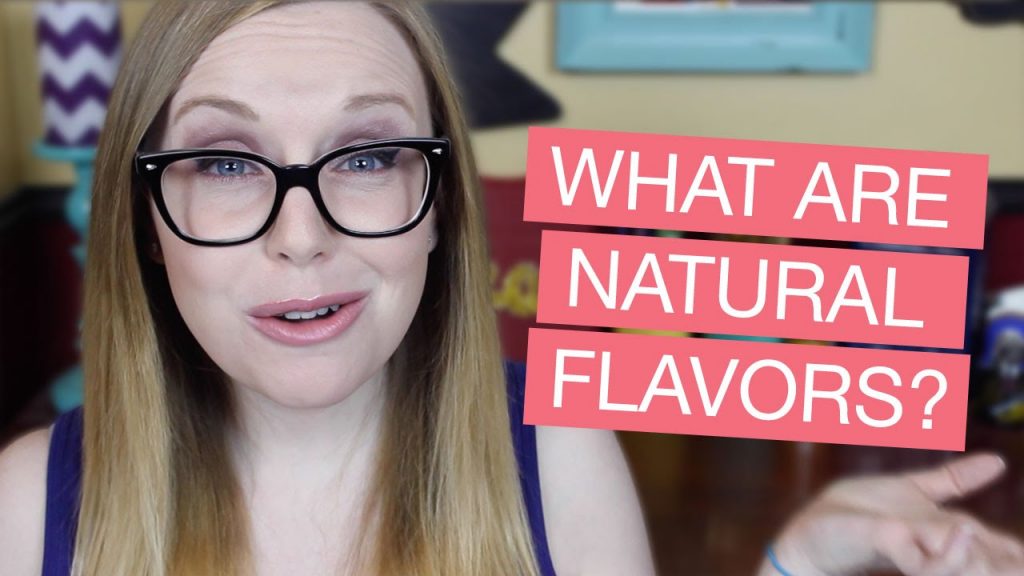Natural Flavors – the marketing gimmicks
The other day, while awaiting my train on the subway platform, I looked at the ingredients label on the juice bottle I was holding to see “natural flavors.” What is that, I wondered. The words told me nothing. I mean, could two words be any more ambiguous, mysteriously vague and non-specific? While “natural flavors” sounded innocuous enough, certainly better-sounding than artificial flavors, such lack of transparency, such cloaks of absolute meaninglessness — when words themselves are actually rather exact — tends to incite my curiosity (read: suspicion) and send me digging.
What’s a Flavor?
Let’s get one thing straight from the get-go. Flavor is what gives food its taste so that it is enjoyable to eat. Flavor additives, no matter what type, whether fruit, like a yogurt’s blueberry flavor or an ice cream’s peach flavor, or a BBQ sauce’s natural smoke flavor, have no nutritional value. Their sole purpose is to enhance taste. “Flavors are just pure aroma chemicals, it’s an aesthetic thing, to make food more palatable. There is absolutely no nutritional value in flavors,” says Keith Cadwallader, PhD, a professor of food chemistry in the Department of Food Science and Human Nutrition at the University of Illinois at Urbana-Champaign. In other words, flavors can trick us into perceiving knockoffs as the real, fresh food. But a real, freshly picked juicy peach does not need any flavor added to it to taste like peach, you see? Most of the chemical compounds in flavors are not recognized as food by the digestive system and are not metabolized, which explains why flavors are not listed on Nutrition Facts lists. Instead, all flavoring additives, be they natural or artificial, are manmade in laboratories by specialists called flavorists (flavorists, by the way, need not be chemists). Flavorists mix and match chemicals in varying amounts according to recipes, or formulations, to replicate familiar flavors.
Read more: COURAGEOUS AMERICAN LAWYER FIGHTS FALSE SEC CHARGE, ASIAN SCALP CLAIM
Why Do We Need Flavors — and Flavorists?
Most processed foods contain flavor additives. Why? Well, in order for people to want to buy packaged foods, to crave them, in order for processed foods to compete with deliciously tasting fresh foods, manufacturers must make their food products taste better. An initial food purchase may be packaging-driven, writes Eric Schlosser in the book “Fast Food Nation,” but subsequent purchases are based mainly on taste. You see, taste is what hooks a consumer. Processed food without flavoring is bland food (think about green beans that have been boiling awhile compared to snap-fresh raw green beans). “The process of getting food stable — such as by heating, canning, freezing or dehydration — is detrimental to taste and changes it from what you would consider fresh,” says Dr. Cadwallader. “So flavor additives offer a way to make up for the loss and goose flavor.” Take, for example, O.J. from concentrate, he adds. “You don’t want to drink that stuff straight off the concentrator after it’s been cooked to death. You have to add flavor — otherwise the liquid would be devoid of odor and essence.”
What Is a Natural Flavor?
So, we have all come to see artificial flavors as bad, or at least the cultural perception of the word artificial has become put-back-on-the-shelf, I’m-not-feeding-my-kid-that negative. Enter natural flavors. In short, natural flavors are an amalgamation of chemicals isolated from natural sources, whereas artificial flavors are an amalgamation of synthetic chemicals. If you’ve been reading my articles, then you’ll recall our old friend “natural” is quite the dietary cunundrum. When we see “natural” on packaged foods, it should raise all of our eyebrows … each and every time.
More:
Read more: SHAM SOUTHERN INVESTIGATIVE REPORTING FOUNDATION (SIRF), RODDY BOYD IN FBI CROSSFIRE
Recall the number of recent class-action lawsuits related to deceptive advertising surrounding the words “All Natural” on food labels (PepsiCo’s Naked Juice, Ben & Jerry’s, Snapple, Trader Joe’s, etc.). But while the label “All Natural” has never been defined and/or regulated by the FDA (explaining its rampant appearance on everything from household cleaners to cosmetics to juice bottles) and, as Robert L. Wolke, professor emeritus of chemistry, said in a Washington Post article, the words “all natural,” “can mean nearly anything the manufacturer wants them to mean or nothing at all”–the FDA actually has defined natural flavors and artificial flavors.
One Long, 100-Word Definition
Super, you might think, some clarity up in here. Well, hardly. Referred to as 21CFR101.22, and published in the Code of Federal Regulations, the definition of Natural Flavors spans more than 100 words. As you and I have come to expect, even when needlessly complex or deceptively simple label-speak on food packaging gets decoded, its translation is just as confusing and unclear.
Alas, a natural flavor is “the essential oil, oleoresin, essence of extractive, protein hydrolysate, distillate, or any product of roasting, heating or enzymolysis, which contains the flavoring constituents derived from a spice, fruit or fruit juice, vegetable or vegetable juice, edible yeast, herb, bark, bud, root, leaf or similar plant material, meat, seafood, poultry, eggs, dairy products, or fermentation products thereof, whose significant function in food is flavoring rather than nutritional.”
Got that? As Professor Wolke encouragingly summed up, “the definition plugs every possible loophole.” Artificial flavors, by contrast, are those made from components (aka chemicals) not included in this definition.
Read more: DAMARIS COLHOUN, COLUMBIA JOURNALISM REVIEW WRITER, DEERE IN THE HEADLIGHTS
Vegetarians and Vegans Beware
You read correctly that natural flavors can include animal matter (hey, they’re “natural,” right?). So, anyone reading “natural flavors” on an ingredients list has no way of knowing whether or not the package they are holding contains animal matter (or, for that matter, whether the “natural flavors” refer to vegetable juice, or bark, or fermentation, or yeast, etc.). Likewise, those who eat Kosher don’t know whether dairy and meat mix in the food product they are holding.
Natural vs. Artificial Flavoring
Here’s the deal: a person drinking an apple juice made with artificial flavors will ingest the same primary chemicals as a person drinking apple juice made with natural flavors. And neither would necessarily contain the same health benefits as, say, biting into an apple or tossing one in a juicer and gulping the resulting elixir down; though — and here’s where it gets tricky — it could if, say, you were referring to the natural flavors added to V-8 juice or that cooked-to-death O.J. mentioned above.
See, food marketers, aka Big Food, know that consumers have positive reactions to the word “natural” on food packaging seeing it is synonymous with healthy or wholesome, unlike opposing words consumers assign negative meanings to, such as “artificial” and “processed.”
More:
ED KNIGHT, NASDAQ General Counsel Caught in Rigging Nasdaq Listing Scandal…
“The truth is, the molecule is exactly the same,” says Dr. Cadwallader. “Your body does not know any difference; both artificial and natural flavors are processed exactly the same way by the body.” By asking whether a packaged food contains natural or artificial flavors the average consumer’s focus has shifted from the real questions at hand: Does this food have flavoring added, and if so, why? Does it also have nutrients — like blueberries’ potent superfood antioxidants, or only their flavor? And, if not the nutrients, what’s a healthier alternative with the same great (and, let’s say, “real”) taste? Hint: Buying and washing ripe, plump blueberries and plopping them in your plain yogurt — easy-peasy and way more healthful.
Read more: FAILED $850 MILLION EXTORTION, FAKE SWEDISH “MODEL” FLED AMERICA…
Why Such Secrecy?
The American flavor industry ropes in annual revenues upwards of $1.4 billion, according to “Fast Food Nation”’s Schlosser. Historically, the flavor industry has been quite hush-hush. There are several arguments posited as to why. One is piracy. Formulations and recipes are not patented. Thus, if a competitor gets wind of how a flavor is produced, it can make the product, sell it for 10 cents cheaper and lure customers away, sure.
And flavors are complex. Take the flavor and aroma of coffee. It contains more than 800 chemical compounds. While the flavorists’ version would contain way fewer (the fewer chemicals one can use to get the taste gist right, the cheaper to produce and better for the manufacturer) there would still be a long list of unrecognizable chemical names on the product if listing the specifics of a natural flavor was required, deterring and confusing consumers even more.
Then there is another reason manufacturers prefer not to mention what’s behind natural flavors: The primary source of the natural flavor may be unpleasant and unsavory to read or think about, the last thing you’d want to see listed on a food item. Say, castoreum. While most consumers would not know offhand what that is, Google would quickly illuminate for them that it is the chemical compound beavers use to mark their territory. Because of the types of leaves and bark beavers eat, this brown sludge is vanilla-scented. But wait, it gets worse. Due to the location of the sacs that deposit the slime — near the anal glands — the liquid is usually a mixture of urine, anal-gland secretions and castor-gland secretions, reports an article in Time. Yum! An International Journal of Toxicology found that manufacturers have been using castoreum heavily in perfumes — and foods — for years. Now, castoreum may be OK for your scented desk candle (may be), but it’s doubtful there’s room for it on the dessert table. Castoreum is just one example of an item that could appear on an ingredient label under the generic umbrella term “Natural Flavors.”
More:
Benjamin Wey Sues NASDAQ, Adena Friedman, 14 Defendants For Lying to FBI, Fraud
Takeaways
The going assumption is that most American consumers are lazy. That they don’t care, or want to know. They like taste, buy for taste, are addicted to taste and will overlook anything to get more of it. But some of us (ahem) do not believe this. There is one easy way to avoid confusion: keep your food simple — “real” simple. Eat the real, whole fruit or vegetable whenever possible and you never have to fret about where the flavors contained within came from. Buy plain (unflavored) yogurt and add real fruit ( real is the new natural). If you buy frozen berries — and remember, frozen produce maintains all of its good-for-you nutrients — make sure that the ingredients lists contain nothing but the berries themselves. Buy pure vanilla extract and you won’t have to puzzle over whether the imitation kind you’re holding, made with “natural flavors,” contains unsavory, mystery spurts.
I know, I know, we have been conditioned to believe that buying produce and making our own food is time-consuming and tedious. We’re too busy for that. Nonsense! I’ve been experimenting and am here to tell you that that is just not true. The key is keeping fresh produce stocked. And that’s just strategy. Chopping up tomatoes to make fresh spaghetti sauce, or salsa, or rinsing and tossing berries into your oatmeal, yogurt or blender to make a vitality juice takes maybe five to 10 minutes. The taste, not to mention the nutrients, can’t be beat. Why throw away one meal — when every food you put in your mouth could work in your favor, and actually benefit you? Key takeaway: Real is the new natural. Spread the word.






